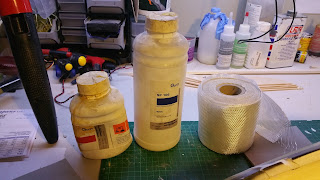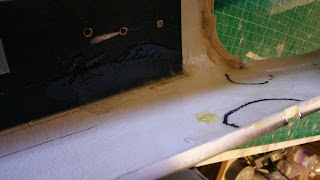On the Sunday after our recent PSSA meet, I went back up to the Orme, as the wind forecast was a lot better than what we had on the actual event days. I'm glad I did!
I met up with Tim Mackey, who bravely agreed to be my launcher (many thanks Tim!) and I set about rigging the big beast. I actually prefer rigging the A10 now than the B52, which is a pain in the arse with the amount of wiring she now runs, along with the rusty rods that hold the tail on.
 |
| All the bits ready to bolt together |
I digress. In no time at all the Hog was air-ready, and Tim had been sampling the big air with his Vulcan to great effect. A quick reading on the Vavuud showed an average of 28mph with 33mp gusts - a fair way off her maiden winds that were 51mph gusting 60!
I decided to go for it, as at least launching from the top gave me a "get-out" on the lower shelf, one of the SW bowl's best features. With a grunt and a good dollop of nose-down attitude from Tim, she was away cleanly and climbing very well.
 |
| A steady climb-out |
I tried my thermal flap setting, that I've changed to a variable volume on one of the 10C's VR knobs, and with a few degrees of down flap, she would again start to climb with the nose into wind, pretty much doubling her height in 20 seconds or so.
 |
| Steady flier |
I passed Tim the TX and he had a few minutes with her in a steady fashion - after all, he flies the opposite TX mode to me. We saw a curtain of rain coming in across the sea, and so after about 20 minutes flying, I called a landing.
 |
| In the groove |
I flew a RH circuit but was (for a change!) a bit far back so she donked into some deep heather with one wing slightly too low - this spun the nose round quick and cracked the nose retention hook off it's mounting internally, and popped the skin seam around the join. Nothing major, but enough to stop her going out again.
 |
| Splat! Still in motion at this point.. |
She will live to fight another day, with only 2 hours' or so of workshop time needed to get ready for more slope-side missions. Each flight is a learning experience for me and heavy models, so once she is fine-tuned (and the pilot too!), I will re-finish her paint job ready for the other two Hogs to fly alongside.
A great outing that was well worth the stick time, I then went on to have 2 or 3 more flights with the Hawk, dodging rain showers as they came through. Now I know she can fly in winds in the high 20's, I'd be happy to have her chucked off in, say, a 25mph with a touch of flap. More wind speeds = more Hog Air Time, which has to be good!
Rock on!

















































